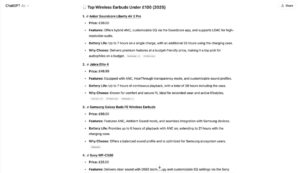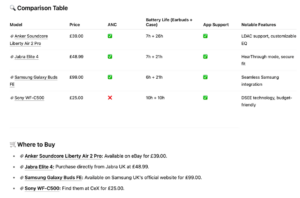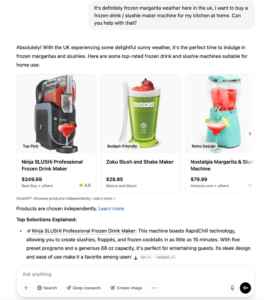As generative AI reshapes how people search, browse, and buy, ChatGPT’s new shopping interface is positioning itself as a potentially exciting new ecommerce channel, presenting product cards, prices, reviews, and purchase links right inside the chat.
We should be clear here, however. This is very early in its lifecycle. While the functionality is impressive, the behavioural shift required for consumers to shop through LLMs (Large Language Models) like ChatGPT or AI-powered search like Perplexity is significant. For most users, searching on Google or browsing Amazon is deeply embedded. LLM-based shopping is still experimental for the mainstream.
Meanwhile, Google remains the dominant force in ecommerce discovery. In 2024, Google processed over 5 trillion searches, a 21% YoY increase, while ChatGPT handled around 37.5 million ‘search’ style queries per day. Google’s AI-powered shopping experiences (via Search, Shopping, and Merchant Centre) continue to drive the lion’s share of buyer intent and conversions.
ChatGPT Shopping is one to watch and prepare for, but it’s a complement to, not a replacement for, Google’s shopping ecosystem.
Much like the learnings from our recent exploration of the impact of AI on Search in Travel & Hospitality, explored in our webinar with Lalit Gupta from Google, the impact of AI on search tools and the changes in user behaviour need to be considered together, before going all-in optimising specifically and solely for the ‘shiney new’ functionality. (You can watch the full webinar here).
In this article, we’ll explore the new ChatGPT Shopping experience and how brands can get themselves prepared for the shift.
When users enter purchase-intent queries such as “where to buy packed lunch sandwich bags” or “best wireless earbuds under £100,” ChatGPT may now respond with a visual shopping carousel, much like Google Shopping or a digital storefront.

Each result typically includes:
Clicking a product opens a dedicated product detail card, sometimes with multiple retailers and price comparison info, resembling a price aggregator like Google Shopping or Kelkoo.
So far, these results appear mainly for users in the US, but OpenAI has begun rolling them out more broadly across Free, Plus, Pro, and even logged-out users, starting with categories like:
As you can see from the images below, in the UK results are a little more basic for the query, but still functional.


Meanwhile, a timely search for a frozen drinks maker during hotter weather here in the UK did trigger the new, richer shopping experience:

More verticals are expected to follow as OpenAI expands product indexing capabilities and direct merchant feeds.
ChatGPT’s shopping suggestions are not pulled from a single source or algorithm. Instead, product visibility depends on a blend of:
Depending on the user’s input, ChatGPT may prioritise certain factors, like affordability, popularity, or brand familiarity, over others.
To streamline the experience for users, ChatGPT simplifies and summarises product data across several areas:
Product Titles & Descriptions
Often rewritten for clarity. Merchants using inconsistent or overly technical product names may find theirs rephrased for easier comparison.
Labels
ChatGPT may apply dynamic tags like:
These are AI-generated and not verified by OpenAI or based on any formal ranking. Sound familiar? This is quite a common behaviour for things like RSA ads in Google, where Headlines are auto-generated using the user’s search query.
Reviews & Ratings
Pricing

Success in ChatGPT Shopping starts with making sure your products can be found, crawled, and interpreted accurately. Here’s how:
ChatGPT uses OAI-SearchBot to crawl websites. If your site blocks this crawler, your products won’t be indexed.
Update your robots.txt file to allow it:
User-agent: OAI-SearchBot
Disallow:
This makes your product pages discoverable and helps AI-driven queries find your listings.
Track performance: ChatGPT-origin traffic can be tracked in analytics platforms using the UTM parameter utm_source=chatgpt.com.
OpenAI is working on a direct product feed submission system—enabling merchants to upload their catalogue data directly.
You can actually join the interest list here.
Getting early access could position your brand for first-mover advantage.
Despite OpenAI’s partnership with Microsoft, testing shows that ChatGPT Shopping is currently pulling data from Google Merchant feeds—not Microsoft’s.
Prioritise feed quality:
This increases your chances of visibility across Google, ChatGPT, and other emerging AI platforms.
Ensure your product pages are structured and optimised for both traditional search and AI indexing:
Check your markup with Google’s Rich Results Test.

To monitor performance, you’ll want to filter for AI-generated traffic in your analytics setup.
In Google Analytics 4, use this source regex to capture traffic from popular AI search and assistant platforms:
^.*ai|.*\.openai.*|.*copilot.*|.*chatgpt.*|.*gemini.*|.*gpt.*|.*neeva.*|.*writesonic.*|.*nimble.*|.*outrider.*|.*perplexity.*|.*google.*bard.*|.*bard.*google.*|.*bard.*|.*edgeservices.*|.*astastic.*|.*copy.ai.*|.*bnngpt.*|.*gemini.*google.*$
This allows you to:
Currently, there are no paid ad placements within ChatGPT Shopping, and OpenAI does not charge commission on referrals.
However, this is expected to change. The development of a feed upload feature and growing merchant interest strongly suggests that monetisation and advertising models are on the horizon.
Brands optimising early will be better positioned for:
Remarkable’s ChatGPT Shopping Checklist
AI is Rising, But Google Still Reigns
Amid all the noise that “AI search is killing Google”, the reality is far more grounded:
So what’s the real story? AI search is exciting, but it’s additive, not dominant. The smart play is not to abandon your SEO or Google Shopping efforts. Instead, focus on building a blended strategy that futureproofs your brand across both traditional and AI-powered search experiences.
The question isn’t “AI vs Google”, it’s “How do we win in both?”
At Remarkable, we’re helping brands build integrated ecommerce strategies that capitalise on AI innovation while staying anchored in the proven power of traditional search, using data (not hype) to shape your strategy. Reach out to the Remarkable team to discuss the future of discoverability for your products, and how you can leverage our team’s expertise to strategically invest in your visibility for the future, whilst maximising performance in the present.
Remarkable are one of the world’s leading digital experience agencies. As a double Platinum Sitecore and Optimizely partner, we offer technology solutions to help brands build experiences that convert.